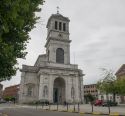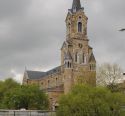The city centre of Verviers and its churches
In the aftermath of the French Revolution, another upheaval was brewing: the industrial revolution. For a hundred years, it will forever change the image of the Verviers city and the surrounding villages such as Pepinster, Wegnez and Dison.
For years, the land of Vesdre would live to the rhythm of the rumbling of cleaning, spinning and weaving machines. The fame of Verviers wool, due to the fresh water of the river, will be worldwide. These textile fibres will then offer the people of Verviers their "golden age". Ambitious, ingenious, many will make a fortune.
This industry declined after the Second World War. Thus the golden age of Verviers gradually faded. But the city has nevertheless kept its dynamism thanks to its "blue gold". As for its glorious past, it has literally crystallized. This is reflected in private mansions, major boulevards, theatres and even churches.
This walking tour is part of three itineraries designed by the network Open Churches,The Verviers Region at the time of the Industrial Revolution (FR)..
Continue on PC Download PDF Continue on mobile
-
Market Square
The Town Hall dominates the Market Square. It was built at the end of the 18th century, an already prosperous period for Verviers. The city has financial resources and wants to make it known (...)
-
Saint-Remacle Church – Verviers
In the lower part of the city, the primary church, dating from the early 19th century, has trendy neoclassical elements. It is inspired by Roman basilicas, especially in interior architecture, with its imposing columns and coffered ceiling (...)
-
The workers' districts
On the left, apartment buildings rise in the rue des Grandes Rames. The city of Verviers is a pioneer in the field of workers' housing (...)
-
The Récollets promenade
The Vesdre, which flows peacefully through the city, is at the origin of everything: the quality of the wool, its industry and the prosperity of the city. The large buildings along the waterfront bear witness to this.
-
Notre-Dame des Récollets Church – Verviers
The origins of this church date back to the end of the 17th century but it has undergone many changes since then. The bell tower, for example, added against the facade in 1892, houses a large chapel dedicated to the Virgin Mary (...)
-
Saints-Antoine-et-Hubert Church – Verviers
This church with its contrasting tones was inaugurated in 1882. It is the result of a significant increase in the population in the 19th century, and the need for the district to have its own church (...)
-
Harmony Park
For almost two centuries, the Harmony Park has hosted the Royal Harmony Society, created by a young music lover. Its concert hall was inaugurated in the presence of one of the greatest violinists of the time, Henri Vieuxtemps, from Verviers (...)
-
The Grand Théâtre de Verviers
Built at the end of the 19th century, on the model of Italian theatres, it replaces the Place Verte theatre, which had become too small for the ever-increasing number of inhabitants to enjoy the vibrant cultural life of the time (...)
-
Sainte-Julienne Church – Verviers
With two bell towers surrounding a large rose window, it is one of the urban landmarks of Verviers, on the heights of the city. Architect Charles Thirion designed the plans for this grandiose neo-Gothic style building (...)
-
Back to the Market Square
The path to the city centre illustrates the eternal Verviers contrast. In the boulevard district, everything is elegant, calm and neat. But as you approach the river, the atmosphere changes; more chaotic and colourful (...)




